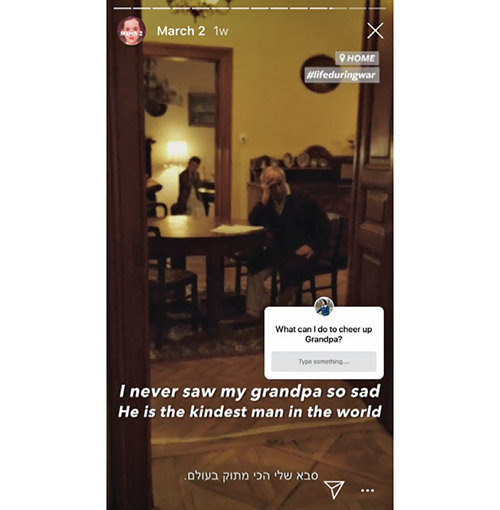

Instagram users may have seen advertisements that read, “What if a girl in the Holocaust had instagram?” “Eva.Stories” is a series of 70 brief clips documenting the life of Eva Heyman, a 13-year-old girl murdered in the Holocaust and portrayed by British actress Mia Quiney. The project went live on Yom HaShoah and was the brainchild of Mati Kochavi, an Israeli tech executive, and his daughter, Maya.
The first series of clips takes place on February 13, in which the viewer is introduced to Eva’s family from her smartphone’s perspective. The viewer is subsequently led through major events in Eva’s life: her 13th birthday and the beginning of her relationship with her boyfriend, Pista, but also the Nazis’ invasion of Hungary and restrictions placed on Jews that came along with this event. Scenes of teenage lightheartedness—Eva dancing with her friend Annie and cousin Marta to Eva’s favorite record, or making a “potion” in her grandfather’s pharmacy—are interrupted with the realities of wartime, such as Marta being abducted by the Nazis and Eva’s grandfather’s business being shut down. We are viewing this as if it’s in real time, but we know the reality of what comes next. Eva doesn’t have that foresight.
Some argue that there are major underlying issues with the project, claiming that it trivializes the horrors of the Holocaust. In an op-ed for Haaretz, Yuval Mendelson voiced these concerns. “First of all, we are talking about a display of bad taste, being promoted aggressively and crudely. Second, and much worse, there will be consequences. The path from ‘Eva’s Story’ to selfie-taking at the gates of Auschwitz-Birkenau is short and steep…”
Kochavi argued that the point of the project was to appeal to younger generations through a medium they can relate to. But one young person in the comments section of the Eva.Stories Instagram page begged to differ. “I’m young, and nobody had to make the Holocaust more accessible for me. I took interest on my own. This is genocide, not a PR project for Instagram.” This might be true for Jewish and Israeli teens who have been taught about the Holocaust extensively in school and may be related to or have met one of the few remaining survivors. But for non-Jewish teens who know little about the Holocaust, Eva.Stories might be the first exposure they have to Holocaust history.
That isn’t to say that Eva.Stories was executed flawlessly; there are a few imperfections. The first is the many embellishments: hashtags, emojis, filters and GIFs. #LifeDuringWar and #ReporterLife are ubiquitous throughout the clips, reflecting the actual Eva’s dream of becoming a photojournalist. The final clip poignantly writes, “Eva, we hope that through this project we made your dream come true.”
This is an honorable sentiment. But do all the hashtags and filters add anything, besides making it glaringly obvious that the viewer is using Instagram? It might even detract from it, because the slang is somewhat outdated, which distracts from the intended message. This ordinarily wouldn’t be an issue, but this project was created for teens and kids—and the terms “bae” (meaning “before anyone else,” or one’s significant other) and #bff are better left back in 2014. The problem with using slang at all is that it’s short-lived, so even if it were current, it would be outdated in a matter of months.
Furthermore, there is the question of whether Instagram is the appropriate platform for Eva’s story. Kochavi said that he chose Eva’s story because there was “something very modern and relatable about her.” Quiney brings so much charm in portraying Eva that it is nearly impossible to dislike her. Because Eva is so captivating, it raises the question of whether she needed to be portrayed through Instagram stories, which are meant to capture peoples’ short attention spans through bite-sized clips.
Instagram as an app is generally used for less serious content: memes, skits and birthday posts. It’s jarring to watch Eva film someone being shot, or her mother curled up in a ball on the couch. That just isn’t something you’d put on Instagram. And maybe the point is that it’s jarring. But some might say that YouTube vlogs (video blogs) might have been more appropriate, because they match the nature of her diary, which is serious. The project could have possibly been advertised through Instagram, and users could “swipe up” to watch the videos on YouTube.
On the other hand, Instagram might have been the appropriate choice because Instagram stories traditionally take place in real time, versus YouTube videos, which can be created far before they are uploaded. Plus, having to go from Instagram on to YouTube is just too much of a hassle in kids’ eyes; having to go to another app means they probably won’t go at all.
Despite the reservations some have about it, Eva.Stories was generally well done, because of the content of her story and the way Quiney portrayed her. In a time where the internet and apps reign, and when anti-Semitism is on the rise, it is important to bring Holocaust history to these mediums so it is not repeated. The fact that the Kochavis successfully tackled this project is impressive, and their goal seems to have been achieved: In one of the latest clips, Eva asks, “Annie, do you think people will remember us?” With 1.6 million followers on the “Eva.Stories” Instagram page, there is no doubt that Eva Heyman will indeed be remembered.
By Ariella Weiss
Ariella Weiss is a senior at the Frisch School who is currently interning at The Jewish Link.











